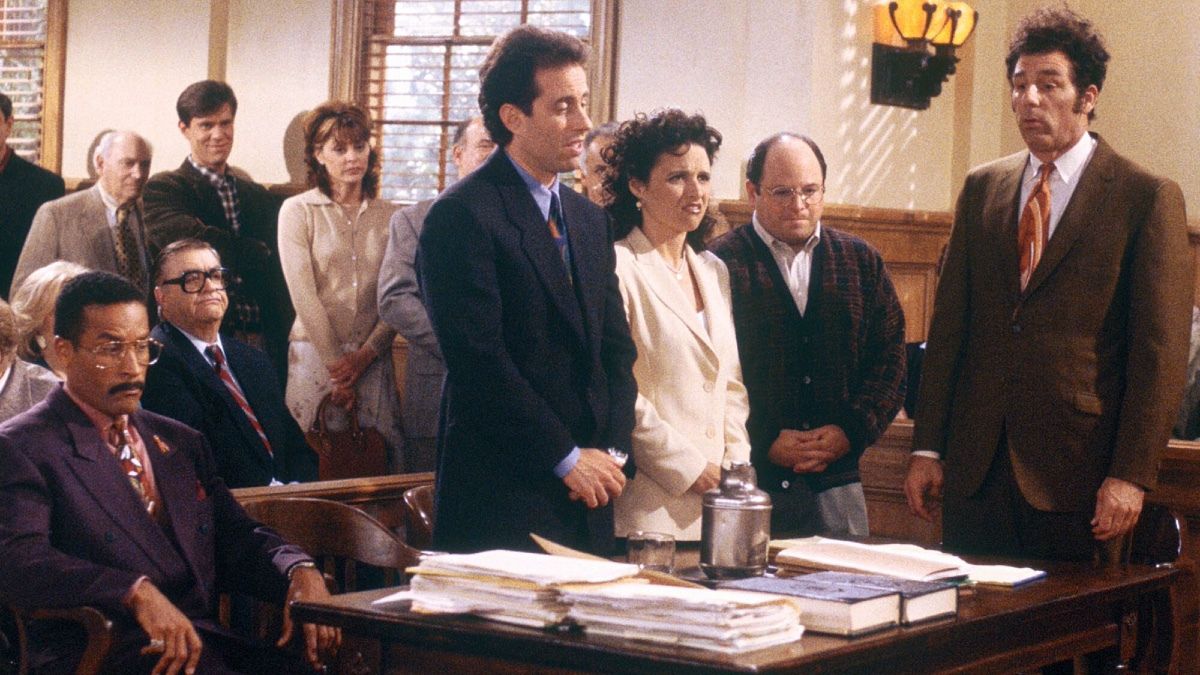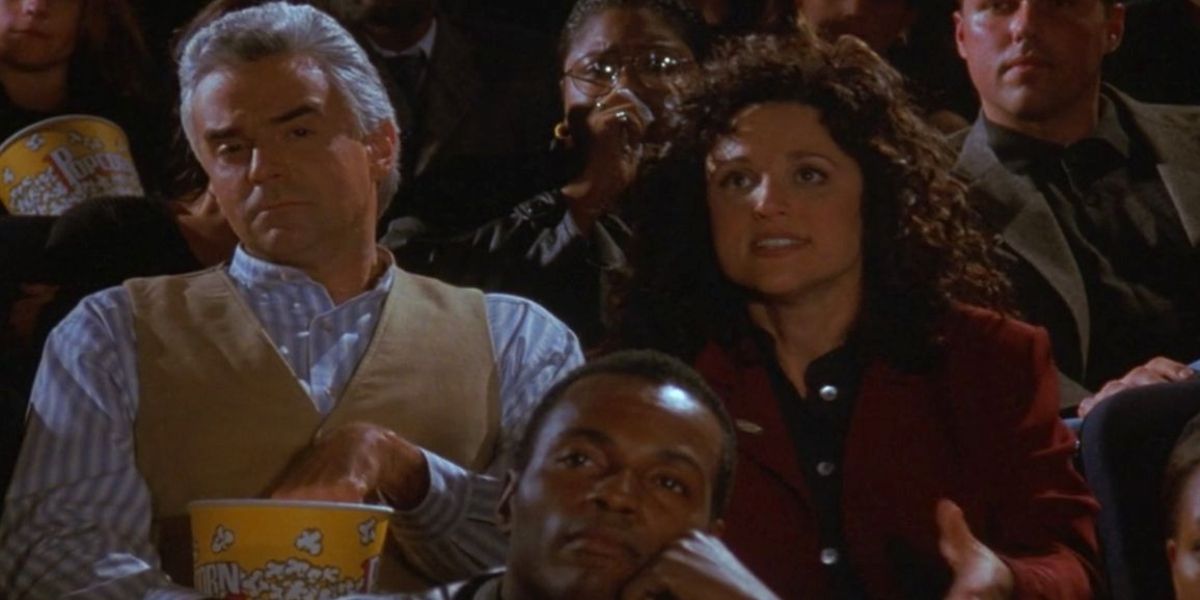Wind sweeps across a desolate and rocky plane – a battlefield strewn with rubble and the long-crumbled remains of structures, dotted with bones and decaying remains. Four people stand across from one another, fists clenched, hearts racing. How they got there and why they must fight no longer matter; all that matters is that only one may triumph. Jerry Seinfeld. George Costanza. Elaine Benes. Cosmo Kramer. Who will win? Who has it in them to spill the blood of their friends? Who is to die? These seven classic, hilarious episodes of Seinfeld hold the key, revealing which of these four has the intellect, agility, tenacity, and sheer power of will to survive this deadly feat of strength. In the fight about nothing, for the show about nothing, who will return their own friends to nothing?
1. “The Bubble Boy” – Season 4, Episode 7

Our four leads encounter a man in a diner who says his son, a boy with an immune deficiency, is a big fan of Jerry’s comedy, right before they leave for a weekend at the family cabin of George’s girlfriend, Susan. The group decides to stop and let the boy meet Jerry while on their way. However, George drives too fast, causing Jerry and Elaine to get lost, leaving George and Susan stuck at the house of the immunocompromised “bubble boy.”
In this episode we see George, Jerry, and Kramer each succeed in different types of battle. George, stuck playing Trivial Pursuit against the arrogant and condescending bubble boy, uses his cunning, wit, and skill of subterfuge to win the game by a technicality, as the trivia card is misprinted with “Moops” instead of Moors. Meanwhile, at a nearby Diner, Jerry is willing to fight a waitress over a picture he signed, which Elaine has made him self-conscious about. This proves Jerry is willing the cross boundaries of contemporary chivalry and honor. Finally, Kramer, by pure accident, commits an act of arson when he leaves his lit cigar near paper in the cabin, burning down the whole structure. Could it be that Kramer has some innate destructive powers inside himself that even he is unaware of?
2. “The English Patient” – Season 8, Episode 17

While visiting his parents at their retirement community in Florida, Jerry defeats Izzy Mandelbaum, an elderly man revered in the community for his strength, in a weightlifting contest, causing Izzy to throw his back out. However, Jerry does not stop there, later besting Mandelbaum’s father and son in additional feats of strength. Jerry Seinfeld proves he has strength greater than that of elderly men, vital information.
Also in this episode, Elaine is sent to Tunisia, a punishment she must serve for disliking the Oscar-winning film The English Patient. However, while en route, her plane is hijacked by Dominican freedom fighters. The episode ends on this scene, the next episode not commenting on how Elaine or the plane escaped the hijackers. Using deductive logic, we can only assume that Elaine singlehandedly stopped the multiple armed assailants on the plane. One must then assume Elaine has fighting abilities akin to Liam Neeson’s air martial character in the film Non-Stop. Clearly, Elaine is a skilled and dangerous combatant.
3. “The Bottle Deposit” – Season 7, Episodes 21 and 22

Kramer and his nefarious postal worker friend, Newman, hatch a scheme to haul a load of cans and bottles to Michigan, where they pay 10 cents for their return, as opposed to New York’s 5 cents, using the truck of mail Newman must transport to said state. However, when Jerry’s car is stolen by an overzealous mechanic, Kramer and Newman eschew their Michigan route to give chase.
In this dilemma, two moments of survival instincts and moral character reveal themselves. One, Jerry is weak and gullible enough to allow his own car to be stolen by a mechanic, flaws which cast doubt on his faculties. But the more important moment in this double episode is Kramer’s willingness to sacrifice in the pursuit of victory. As the mail truck slows, failing to keep up with Jerry’s stolen car, Kramer discards excess weight in the truck by not only throwing out mail and his prized bottles and cans, but even his own friend, Newman. Throughout the nine seasons of Seinfeld, it becomes well established that Newman is a friend as important to Kramer as Jerry, George, and Elaine. However, in the face of possible defeat, Kramer is willing to sacrifice his closest friend to accomplish his task. Here we find a man with no apprehension toward cold, logical cruelty when it behooves him. Unfortunately, it is all for naught, as the mail truck breaks down after the deranged mechanic attacks it with impromptu projectiles – the golf clubs of former president John F. Kennedy.
4. “The Fire” – Season 5, Episode 20

George Costanza is a man of many qualities. He’s cunning, deceitful, bald, often unemployed, and has even lived with his parents as an adult. However, above all, George is selfish – an attribute which would serve him well in a deathmatch. Selfishness is at the core of who George is, as shown in this very episode. While attending his girlfriend’s son’s birthday party, a fire breaks out, and George does not hesitate in making an escape, pushing everyone out of his way, including his girlfriend’s son, mother, and even an elderly woman.
George puts himself first, a dishonor that a warrior seeking to survive a deathmatch must accept. However, does George act selfishly out of self-protection, or mere cowardice? At the end of this episode, George causes mayhem when he screams and runs away at the sight of a prop gun held by a comic at Jerry’s comedy show. Fire is a primal element that can easily conquer even the strongest champion, but a lone gun should be no match for a warrior. George may have an instinct of self-preservation, but when in an unavoidable fight to the death there’s nowhere to run.
5. “The Soup Nazi” – Season 7, Episode 6

Perhaps one of the most beloved side characters of Seinfeld is our heros' most fearsome antagonists: the eponymous Soup Nazi, a genius of soup-making with a heart of ice and no leniency for those who defy him. Clearly, how our leads react to such a tyrant would reveal their true character. So, who bows to the ladle and who usurps the regime?
Jerry and George kowtow to the Soup Nazi, loving his delectable creations too much to fight back. Kramer, who, in a side plot, is intimidated into allowing the theft of Elaine’s wardrobe he swore to protect, befriends the tyrant. All three men, in one way or another, show their cowardice in being unwilling to stand up for themselves. However, Elaine makes a stand against the unjust authority, resulting in her ban from the Soup Nazi’s restaurant. Later, Kramer gives Elaine a new armoire, which he procured from the Soup Nazi, who expresses he would have destroyed the piece of furniture had he known it was going to Elaine. Enraged at this insult, Elaine, upon finding the Soup Nazi’s secret soup recipes hidden in the old armoire, drives the Nazi out of business. Elaine is triumphant, her courage empowering her, fortune shining upon her, villain deposed, proclaiming “I can make my own soup … You’re through, Soup Nazi. Next!”
6. “The Subway” – Season 3, Episode 13

As our four leads take to the New York subway for transportation, we are subject to two displays of weakness. George, succumbing to the temptations of a seductress, follows the woman back to her hotel room. After allowing the woman to tie him up, assuming it is for fetish purposes, the woman instead robs George, but dissatisfied with his lack of cash, steals his clothes as well. Because of this, George misses his job interview and must walk back through the city wearing nothing but a bedsheet, displaying weakness of will and an ability to be bested. Kramer, after striking good fortune with a last-minute horse race bet, is nearly robbed of his winnings on the subway by a fellow gambler. Even though he is rescued by a cop, Kramer was weak in his efforts to fight the thief, which does not bode well for his combat abilities. It seems fitting that a subterranean mode of transportation would lead two characters into brushes with the underworld.
7. “The Invitations” – Season 7, Episode 24
TV Guide once ranked this episode’s ending as number 8 on a list of the “Top 100 Most Unexpected Moments in TV History,” and it’s for good reason, as this episode has one of our main four characters directly responsible for a death. However, before said death, there is an important moment for our assessment of Jerry, as he absentmindedly tries to cross a street, nearly resulting in a car hitting him. Jerry is only saved by a woman passing by who pulls him back, out of the car’s path. Clearly, Jerry is prone to distraction, lacking a level of awareness that could prove fatal in our battle of champions.
We’ve discussed the strengths and flaws of George Costanza at length already, but it would be remiss to not mention that, going into this deathmatch, he is the only one of the four that we know is directly responsible for a death. With his wedding to fiancé Susan imminent, much to his regret and dismay, George begrudgingly picks out invitations for the ceremony. After George selects the cheapest invitations/envelopes available, Susan assumes the task of filling them out, licking the envelopes sealed, and sending the letters off. However, as George and the audience discover after Susan is suddenly rushed to the hospital, the cheap envelopes contained a toxic adhesive that, when ingested, is fatal. Susan dies at the unintentional, yet direct hand of her groom to be, George Costanza (who is none too upset about his freedom from impending marriage). While not planned or deliberate, George’s frugal nature proved to be deadly, creating a familiarity with killing that may aid him in battle.
Conclusion

Seven episodes revisited, four characters judged, the answer to which would survive the deathmatch contained therein, among the strength and flaws of each. So, who survives? Who stands atop the mangled corpses of their friends, the lone victor? The answer surprised even me, as going into writing this piece I had not come to a definite answer. In my mind, I assumed possibly George or Kramer would be the winner, one deceitful and selfish, the other unknowingly destructive and chaotic, things which I presumed meant they would be most likely to succeed in battle. But, what does the show truly tell us?
Much like people deciding who their favorite Seinfeld character is, in terms of the deathmatch Jerry was out from the start. He’s an ineffectual man-child – simply a vessel for the hijinks of his friends. In the above episodes, as well as the rest of the series, Jerry is repeatedly shown to be conflict-averse, only coming to blows over the most menial, pointless topics of contention. Jerry proves time and time again he can only succeed when he is given the advantage, be it him “outperforming” a bunch of old guys in lifting weights, or, with the Season 6 episode “The Race,” getting an early start at a simple footrace. Jerry dies, probably first, probably violently, being the last to accept there must be combat, resulting in the Death of “Superman.”
George, for all his cunning, lies, and self-interest, is not a warrior. When the going gets tough, George Costanza gets going – in that he runs away. For every bubble boy defeated, false identity created, complex lie constructed, or fiancé accidentally killed, there are ten times George has given up or broken down in fear. George is not the knight in armor, out on the battlefield spilling blood, he’s the Machiavellian advisor to the king, playing power games and tricking others. However, in a four-way deathmatch, there’s not much use for palace—or in George’s case, apartment/dating/job—intrigue and subterfuge. George dies, running, kicking, and screaming till the bitter end, but he cannot escape death.
Kramer is hard to pin down precisely, as his biggest strength is his chaotic, seemingly random powers of chance, which have been both a blessing and a curse. There’s a distinct chance that, somehow, without even trying, Kramer decapitates his three friends immediately in battle, or some similar, completely unpredictable scenario. However, going purely off what we know from the show, and these seven episodes in particular, Kramer’s karmic chance of domination is simply too unreliable to count on. When it comes to the K-Man’s actual abilities, he’s often clumsy, easily discouraged (just look at his many fleeting schemes and fads), and overall unproductive. Perhaps Cosmo is secretly a vessel of the universe’s chaotic energy, wielding a destructive power unbeknownst to him, but he’s simply too unpredictable to put my faith in. Most likely Kramer somehow ends up accidentally injuring, if not killing himself.
So… it's Elaine? I mean, I’ve always liked Elaine, but she’s winning the deathmatch? I’ve always envied her “devil-may-care” attitude, spunky sense of fashion, and witty retorts to her idiotic male friends, but I didn’t think she would be the winner. Is it really her?
Yes. It’s Elaine. Elaine would win the blood sport and here’s why. What are Elaine’s classic character traits and flaws? She’s independent, cynical in the face of opposition, crass, strong-willed, and determined to a fault. Elaine stands up to the Soup Nazi. Elaine seemingly stopped or, at the very least, survived a plane hijacking. Elaine survived being in a stalled subway car with the power out, fought her way to an airplane bathroom, overcame a guy exposing himself in front of her, and threw George’s toupee out the window. Elaine is the most independent, confident, aggressive, and strong-willed of our four leads, and thus she will succeed in battle. She triumphs the most in the show, stands up for herself the most, and is the least cowardly of the four. Frank Costanza may think she's supercilious, but it seems she's earned it. Elaine punches, hacks, slashes, and little kicks her way to victory, ridding herself of her doofus friends in the process. Sure, it’ll be difficult, but it must be done. Elaine wins the deathmatch. Elaine is master of her domain. Cue Freeze Frame. Cue Seinfeld theme. Roll Credits.
All nine seasons of Seinfeld begin streaming on Netflix on October 1st.

























